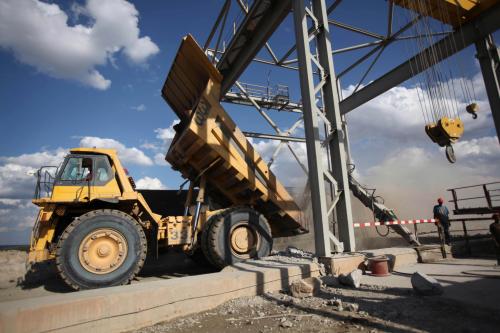This is the third in a series of four blog posts about resource-rich sub-Saharan African countries (specifically, Nigeria, South Africa, Angola, Equatorial Guinea, Gabon, Sudan, Tanzania, Zambia, Botswana, and the Republic of Congo). The first focused on some surprising findings about resource-rich Africa and the second focused on how reinvigorating growth can help propel the region’s economic fortunes and reduce poverty.
Africa faces many challenges. By 2020, the continent will be the world’s last frontier to ending extreme poverty. To generate stronger and sustained growth in resource-rich Africa will require more and better human and physical capital and stronger market and government institutions. Given the smaller size of some sub-Saharan African countries, policies to improve the endowment of capital need to be supplemented by efforts to create larger markets that cross borders and make those countries more attractive to both foreign and domestic investors. A more integrated region will help overcome the burdens of low density, thick borders, and long distances that still negatively affect sub-Saharan Africa.
My colleagues and I find in a recent report that spillovers from the three large, resource-rich, middle-income countries in sub-Saharan Africa (South Africa, Nigeria, and Angola) to their neighborhoods or the rest of the region are negligible. There is little evidence of statistically significant links between growth rates across sub-Saharan Africa as a whole. Modest integration limits the attractiveness of the region to both domestic and foreign investors. (We define neighborhoods according to four criteria: a common border between countries, distance, geographical region, and membership in a formal regional economic community.)
The parallels with the first round of East Asian tigers and the next generation of Asian countries is important. Taiwan, China, Singapore, and Korea integrated globally first, taking advantage of the unique international landscape in the first three decades after World War II. For the Asian tigers, integrating regionally was not practical or feasible until the late 1970s. The next round of East Asian countries, such as Malaysia and Thailand, integrated both regionally and globally based on a consistent platform of WTO accession and taking advantage of the production chains that started or ended in the Tigers and then shifted to China. East Asia also benefitted from abundant low-cost labor moving out of agriculture or planning to make the transition.
The 3 Ds
Consider in turn the three Ds—Density, Division, and Distance—that are hampering stronger and sustained growth from taking hold.
Density. The median population of sub-Saharan African countries is about 12 million, compared with 50 million in emerging Asia (excluding China and India). The resource-rich countries in sub-Saharan Africa are urbanizing rapidly and half of the population already lives in cities. These countries are also substantially more agglomerated than the continent as a whole. Nonetheless, the correlation between urbanization and per capita GDP in Africa is weak. Sub-Saharan Africa can do better in delivering scale efficiencies through urban agglomerations.
Division (thickness of borders). Economic fragmentation impedes trade and other interaction between countries. Using statistics on border restrictions, we find that divisions between countries in sub-Saharan Africa have increased over the last decade, more so in resource-rich than in resource-poor countries.
More restrictive borders in resource-rich sub-Saharan Africa put those countries behind both resource-rich countries in other developing regions and the resource-poor sub-Saharan African countries. Those that are more open to trade, ideas, and (appropriately sequenced) inflows of foreign capital are better integrated into the global economy and benefit from their interactions with other countries. The thick borders around resource-rich sub-Saharan African countries, especially the three large middle-income countries, are a major deterrent to growth spillovers to their neighbors. Thick borders between resource-rich and resource-poor countries are the opposite of what trade theory suggests for countries with complementary production and export structures.
Distance to markets. Thick borders exacerbate economic distances. An index that combines geographic distance with policies to reduce divisions indicates that foreign market potential is higher in most other developing and advanced regions than in sub-Saharan Africa. International trade patterns are influenced by proximity to large markets and they, in turn, impact economic development. While geographic distances to world markets for many African countries are not very different from those of countries in the largest developing regions, challenges in reaching these markets result in higher economic distances for sub-Saharan Africa. Economic distances are similar for resource-poor and resource-rich sub-Saharan African countries.
Intraregional trade is rising from low levels
Sub-Saharan Africa intraregional trade has doubled since 2000, but the pace of increase has lagged that of East Asia and the EU. Despite the increase, intraregional trade accounts for 25 percent of overall sub-Saharan African trade and even less of the trade of resource-rich sub-Saharan Africa, compared with 63 percent in the EU and 47 percent in East Asia. The modest levels of intraregional trade reflect the limited integration among the sub-Saharan African countries and the low participation in regional and global value chains.

The current rapid technological advances are producing a skill- and capital-biased globalization that creates unique challenges for resource-rich sub-Saharan Africa. Stronger global integration of the region is necessary, also starting with the WTO. Regional integration needs to proceed even more forcefully because, except for Nigeria, the resource-rich sub-Saharan African countries have smaller populations, smaller markets, and smaller middle class than comparators in other regions, and attractive investment options often require scale. Opening the borders will allow for positive spillovers from the resource-rich countries of Africa to their neighbors through increased intra-industry trade in the non-resource sectors and access to more firms and households. It will also allow these resource-rich countries to create or access regional production networks besides those in commodities, generating a growth impetus. The future lies in substantially deepening regional integration, especially around the large middle-income countries.
The Brookings Institution is committed to quality, independence, and impact.
We are supported by a diverse array of funders. In line with our values and policies, each Brookings publication represents the sole views of its author(s).







Commentary
Integrate regionally for stronger, sustainable growth in resource-rich sub-Saharan Africa
October 24, 2018